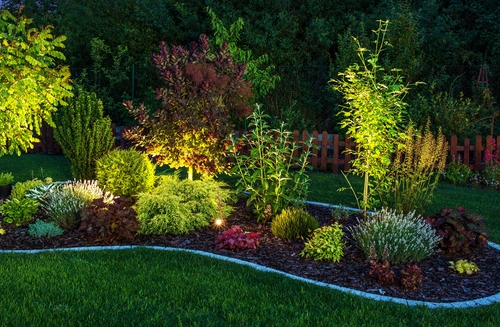Posts Tagged Landscape Maintenance
How To Find A Good Landscaper in Rohnert Park
As per the survey conducted by the National Association of Landscape Professionals, 67% of Americans agree that professional landscaping allows them to have beautiful yards. You, too, want an inviting yard and outdoor space. However, the challenge is finding the right landscaper. In this article, you will find out how to find a good landscaper Rohnert Park.
Identify what you want

There are different types of landscapers. Each specializes in different things. Some specialize in lawn installation and maintenance. Others, solely do gardening. While others offer full-range services, including landscape design.
After identifying what you want, you can know what type of landscaper to look for.
Research local landscapers
First, go to Google and search for landscaper Rohnert Park. You want to find landscapers that provide their services in your area.
Make a list of landscapers you could potentially hire. Then compare them. Compare services offered, price, and reputation.
Reputation is vital as you want to hire a company that provides quality services. So, look for reviews of the company on sites such as Yelp, BBB (Better Business Bureau), and Angie’s List. Also, check the landscaper’s website for testimonials or ask them for referrals.
Request quotes
At this point, you have identified a few (2 to 3) landscapers you consider best suited to handle your project. Go ahead and ask for quotes. Most landscapers will prefer to come and see the scope of the project before they can provide an estimate.
This one-on-one meeting is an opportunity to vet them further. As much as the budget is essential, it should not be your sole focus. Ask about:
- Insurance: you do not want to be liable to injuries to the people working in your property.
- Completion timetable: Landscapers often have multiple clients, and a company might delay your work as they are already engaged in several other projects.
- Guarantees: A good landscaping company will offer at least a 2-year guarantee on their work.
- How they will handle your project: By asking this question, you get to gauge how experienced and knowledgeable a contractor is.
Consider their personality traits
You don’t just need a landscaper with the right skills and qualifications. You need one that will understand what you need and work with you to make your dream yard come true. So, as you talk to them, look for the following personality traits:
- Excellent communication: You want a contractor that explains the processes and work involved clearly.
- Patience: A patient contractor will not only listen and but also understand your needs.
- Willingness to work with your ideas
- Creativity: so that they can improve your ideas
Do you need a landscaper Rohnert Park? Contact us today. We specialize in landscape repair and maintenance and irrigation. We are also specialists in xeriscape or water-saving landscape design.
The One-Third Rule of Pruning Shrubbery
Pruning your shrubs can give your entire landscape an amazing aesthetic appeal. Ideally, there are typically two types of landscapers when it comes to pruning shrubbery; those who prune timidly from fear of damaging their bushes and those who prune aggressively to come up with perfectly shaped shrubs. However, to achieve the best outcome when pruning your bushes, trimming about one-third of the good wood is ideal.
If you prune more than this, you risk exposing your shrubbery to excessive damage, which could stunt its growth. Prune less than this, and you might not do much to improve the appeal of your shrub.
Read on to learn about the one-third rule:
Why The One-Third Rule?
Moderate pruning is pivotal when it comes to stimulating vital growth. Plants typically live in a balance between the below-ground and above-ground parts. Once the plant loses a number of stems through pruning, it tries to gain back the balance by pushing forth new growth. This regrowth is essential, especially in moderation, since it allows the plant to heal as well as simulates growth from dormant buds.
If your shrubbery loses too much leafy growth, it goes into panic mode. This can be shown by the appearance of water sprouts or suckers, which can leave your shrubs ragged looking. Even worse, this suckering can go on for a long time, making landscape maintenance tough.
Use the Rule on Established Plants
The one-third rule is ideal for your fully established shrubbery- plants that have overcome their transplant shock. If you have newly planted shrubs, give them a grace period of one or two seasons before pruning them to ensure that their root systems become established enough.
Use the rule on small ornamental trees and shrubs. As for larger shade trees, limit pruning to at most a quarter of the total branches. While growth on shade trees is stimulated into new growth through assertive pruning, its pruning shouldn’t be as vigorous as that of multi-stemmed shrubs. Pruning the trees often is vital since it reduces the chances of wind damage.
When Might The one-third Rule Not Be Enough?
If you neglect your shrubbery for too long, it might overgrow and get out of control. Normal pruning might not suffice. For such shrubs, rejuvenation pruning (a severe form of pruning) might work. While rejuvenation pruning will leave the shrub looking unattractive for a while, it allows it to reform itself into a better shape.
As long as you show your shrubs love, they will light up your landscape. Pruning ensures that you can shape your shrubs to fit right into your ideal landscape design. Consider using the one-third pruning rule to improve the appeal of your landscape.
Shrubbery Like Boxwood, Lavender, and Camellia
Adding shrubbery to your home’s outdoor landscape is a wonderful way to frame your garden and border a winding path. One particularly popular way for doing both, or either, is with evergreen shrubs.
Benefits of Evergreen Shrubs
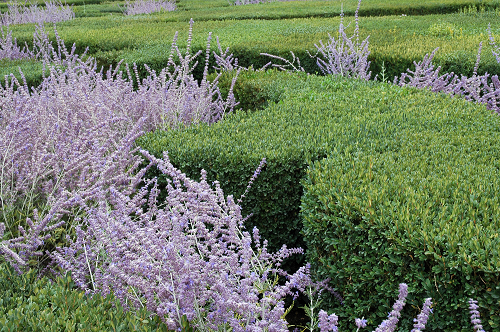
Evergreen shrubs are shrubs that can be a permanent fixture in your garden thanks to the fact that they will last all year.
In fact, evergreen shrubs like fatsia, lavender, and camellia can create beautiful flower displays and perfume-like scents throughout the year, even when everything else in your garden appears to have fallen dormant.
Evergreen shrubs will often be naturally variegated and create a colorful cascade of colors over your garden. Some shrubs are like trees and come with needled or broadleaf foliage.
Adding shrubs to your property will beautify the landscape all four seasons and provide a smooth transition between taller trees and the groundcover plants lining your walkway or garden.
Shrubs can be used for a number of different purposes beyond lining walkways and framing your garden as well.
Shrubbery can provide groundcover on slopes, buffer ambient noise from entering your home, and provide a breathtaking backdrop for your garden.
Boxwood Shrubs
One of the easiest-to-work-with types of evergreen shrub is boxwood shrubbery. Boxwood is hardy to zone 6, which essentially means that it will maintain its integrity no matter what nature throws at it.
Boxwood also fits most people’s initial idea of a shrub – boxwood has tiny, glossy foliage that can be hedged by Xeriscape’s landscaping experts into just about any desired shape.
Most homeowners like their boxwood shrubbery to be a few feet in diameter but, left to its own devices, boxwood can grow up to two dozen feet tall! This is a hardy shrub that will grow well in moderate sun and ligher shade.
Lavender
Lavender is a drought-tolerant plant that is a kissing cousin to mint, and each has a similar fragrance. Lavender, though, is a perennial shrub that has a lot of different size and color options to match your landscape.
There are actually four main types of lavender that homeowners in North America typically consider for their gardens: English lavender, Spanish lavender, Portuguese lavender, and lavandin.
English lavender owes its name to the English lavender trade of the 1700s and the fact that it smells so wonderful. English lavender can furnish homeowners with those variegated colors alluded to above: purples, violet, mauve, and mixtures of all three are afforded by English lavender.
Spanish lavender will come with pink and purple petals and have a unique pine scent. Portuguese lavender (a.k.a., Broadleafed lavender), on the other hand, will have paler purple leaves that are slightly larger.
Portuguese lavender can cross-pollinate with Engligh lavender, and both types are used in aromatherapy. The camphor in Portuguese lavender is good for attracting friendly insects into your garden and lending a sense of exotic variety and soothing color.
Lastly, lavandin might be a fancy name in this context since lavandin only means a cross between English lavender and Portuguese lavender. Lavandin produces sterile seeds but can grow in hot, arid climates and live through periods of sustained drought.
Camellia
Camellia is also a type of evergreen shrubbery, but the flowers of a blooming camellia are truly unique in certain species. There are more than 300 species of camellia, and approximately 3,000 hybrid species. Some camellia flowers are double.
Where does camellia work? Woodland gardens with dappled sunlight or gardens with slightly acidic soil are especially promising foundations for camellia.
Ask Xeriscape about the possibility of installing camellia shrubbery around your garden because the flowers come in a variety of beautifying colors: pinks, reds, yellows, and whites are common. Contact us for more information.
Why is Fertilizer Necessary? Is Organic Really Better?
Fertilizer has a host of nutrients that will enable your lawn and garden to reach its full potential, which really everyone wants.
The shocking thing is that fewer than half of home gardners in the United States use any kind of fertilizer in their yards, according to a Gallup Gardening Survey.
Why is Fertilizer Even Necessary?
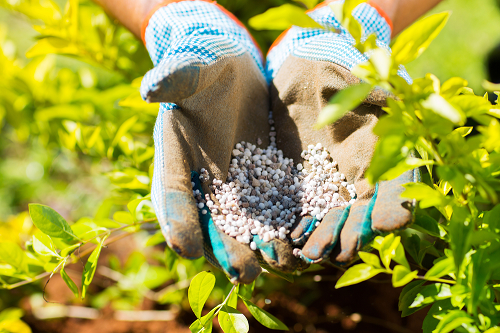
Basically, if you’re not using some kind of fertilizer to nourish your lawn and garden, then your grass and plants aren’t getting the nutrients they need to thrive.
Even if you’re fortunate enough to live on a property or area of the country with fantastic soil, your plants will naturally pull nutrients from the soil to grow. This process depletes the soil and underscores the need for any homeowner serious about lawn care and gardening to invest in a good fertilizer.
The more plants that you have in your garden and the more depleted your soil, moreover, the more that you’ll benefit from fertilizer. Xeriscape can come by and measure your soil’s PH and perform a soil analysis to detect the levels of critical nutrients.
When you get the right fertilizer for your lawn – the “right” fertilizer is one that helps overcome particular deficiencies with your soil – you’ll have more beautiful flowers and much healthier produce.
Nitrogen, Potassium, and Phosphorous
Nitrogen, potassium, and phosphorous are particularly important nutrients found in all fertilizers. Nitrogen allows plants to grow more robustly by giving plants the proteins needed for plants to create new tissue in the growing process.
Your plants will be constantly assimilating carbon, hydrogen, and oxygen from the ambient air and water, but nitrogen is something that plants don’t always get in adequate amounts. That’s why plants gorge on nitrogen when the nutrient is around.
What about potassium and phosphorous? Potassium serves a number of different functions for your plants, including: helping your plants fight off diseases, improving your plants metabolism, and improving your plants’ ability to create carbohydrates.
Phosphorous is also critical for plant growth since it gives your plants the nutritional tools to grow strong roots, flowers, buds, and new seeds. Plant’s need a PH level of around 6.7 to effectively absorb phosphorous. Set up an appointment with Xeriscape to make sure your soil’s PH is good.
Micronutrients Calcium and Magnesium
After getting in to this trio of all-star fertilizer nutrients, you should know that nitrogen, potassium, and phosphorous are known as fertilizing macronutrients (really important!) but fertilizers also contain secondary micronutrients.
Secondary nutrients include calcium (used for fighting diseases and cell membranes) and magnesium. You might want to consider using an organic, at-home fertilizer like eggshells because these lower your soil’s PH and provide calcium to your plants.
Magnesium is actually hugely important and almost considered a macronutrient since plants need this nutrient for chlorophyll and turning sunlight into energy. Plants couldn’t really grow without magnesium!
Organic and Synthetic Fertilizers
Organic and synthetic fertilizers contain many of the same nutrients, but the source of each is different and each enters the soil to nourish plants at different rates. Organic fertilizers enter plants more slowly, so now is the time to apply organic fertilizers.
Compost, manure, and mulch are organic fertilizers that might work for your yard. Home garden experts recommend applying organic fertilizers like those made from plant and animal byproducts (e.g., bone and plant meal) in the fall so that the soil can assimilate those nutrients over many months – in time for spring’s blooms!
If you determine with Xeriscape that your garden could benefit from a quicker-acting solution, then a synthetic fertilizer might be more desirable.
Synthetic (man-made) fertilizers are often cheaper than organic alternatives, and synthetic fertilizers let you get the exact combination of nutrients that will enable your lawn and garden to thrive! Schedule an appointment with Xeriscape today and have your soil tested. Contact us for more information.
Strategies for Getting Your Lawn Ready for Cooler Weather Ahead
Although the month of August is in what people call the dog days of summer, you have to realize that the first frost is right around the corner. The season’s first frost might well come at the end of August or early September.
When the first frost of the season hits, most of your annual plants will wilt and perennials will be sent into their dormant phase for the hardier winter months ahead.
While these effects can’t be avoided, there are a lot of steps that you can take to fortify your lawn for winter.

Keep Up Irrigation
Your lawn has a kind of wisdom all its own. In the fall, the grass will stop putting so much energy into growing new blades and put those resources into creating a resilient root system to survive the coolet months ahead.
The thing to realize is that you have the chance to significantly strengthen your grass’s root system by watering your lawn right now. Xeriscape is a landscaping and irrigation company that can give your yard the nourishment that it needs.
Your lawn will naturally grow less bounteously in the late summer and early fall. That said, your lawn will still benefit from giving it the three main ingredients that it needs to grow – nitrogen, potassium, and phosphorous. Xeriscape can help here as well.
Repair and Weed
There’s an expression that when you fail to prepare you actually prepare to fail. That might sound harsh but what’s undoubtedly true is that homeowners who have an eye towards the future usually have the best yards.
Think of late summer and early fall as your opportunity to create a lush landscape for spring next year. Xeriscape can help you fill in bald patches, or you could look into a grass repair kit that includes seed, fertilizer, and mulch.
After you’ve done the real heavy lifting by repairing bald spots, you might want to look into uprooting weeds so that everything can grow to its full potential.
The thing to bear in mind is that weeds can fortify themselves and regrow with renewed vigor in early spring next year if they’re not dealt with soon.
Rake Up Leaves
A lot of people are loathe to rake up their leaves because they have such a beautiful appearance in your yard.
That’s true – a defoliating maple tree, for instance, can be breathtaking….and, at the same time, be ruining your yard and actually jeopardizing your health!
Lawns have to breathe in the sense that leaves that are allowed to linger on your lawn will prevent sunlight and air from getting to your lawn, which will cause your grass to be less healthy than it otherwise would be had you raked right away.
Leaves also decompose very slowly so that, if you don’t rake leaves in the fall, you’ll have a layer of basically intact leaves over your yard all winter. Snow mold and brown patch are both serious possibilities if leaves are allowed to linger all winter.
Fungal infections and health problems could also crop up if you don’t rake away leaves. Xeriscape can help with all kinds of landscaping, including getting leaves off the property. Leaves that get matted now could prevent fresh grass from growing in the spring.
Use Leaves to Compost
All of those leaves that you’ll eventually rake up can be put towards composting in the spring. You might want to consider putting fallen leaves in a compost bin and allowing decomposition throughout the winter. Turn the compost over regularly to have consistent temperatures, or simply rely on Xeriscape for your lawn care needs! Contact us for more information.
How and When to use Fertilizer in Your Lawn and Garden
Time for our annual reminder that fall is one of the best times to apply fertilizer to your lawn. Why? Because a proper application of fertilizer before the first frost will help it survive a harsh winter. Certain plants such as pansies, Iceland poppies, and calendula, usually need to be fertilized now, too, because most soil doesn’t provide the essential nutrients they need for optimum growth.
Guide to Healthy Lawns

Sonoma County is home to more than a dozen grass species. These cool-season grasses actively grow in the spring and fall. That’s why it’s important to fertilizer during those times of years. Experts recommend that at least one fertilizer treatment be a “complete” one that includes all three primary nutrients a healthy lawn needs: nitrogen, phosphorus, and potassium. Otherwise, most established lawns need only a nitrogen rich treatment on a regular basis.
Some signs that your lawn needs fertilization include:
- Discoloration
- Slow growth
- Weed or other pest invasion
The key to a health lawn is making sure just the right amount of fertilizer is applied over the course of a year. Too little and you have the problems listed above; too much and root growth slows down, leaving your lawn vulnerable to problems like insect infestation.
Fertilizer as Part of Regular Landscape Maintenance
A lush, green lawn depends on more than watering and mowing. It’s the result of regular, strategic maintenance throughout the year. DK Landscaping’s innovative lawn maintenance plan helps your yard stand out in the neighborhood.
From streetscapes and business complexes to condos and single-family homes, DK Landscaping delivers consistent, reliable landscape maintenance services to local properties. Any business or homeowner who wants to protect their investment should consider using a service like ours that gets a landscape on a regular maintenance schedule.
Helping our commercial and residential customers enhance their landscape is a vital part of what we do. We know the best time to fertilize, what spot treatments are needed, and when it’s the best time to uproot weeds, aerate, mow, and mulch. We want to help you get and keep a healthy and beautiful lawn!
As professional landscapers we also provide monthly irrigation inspections to help you manage your water use and save money while doing it. Other maintenance services include:
- pH test to check for proper nourishment
- Tree care including trimming, planting, moving, disease control, and removal
- Seasonal color plantings
- Garden bed care including pruning, weeding, fertilizing, and mulching
Learn More
Want to learn more about keeping your lawn in prime condition through the use of fertilizer? Contact us today. We look forward to discussing with you all the benefits of getting on a regular landscape maintenance schedule!
Landscape Maintenance: Simple Guidelines for Reducing Your Long-Term Costs
Beautiful and pristine landscapes enhance the general appeal of homes. In addition, landscape maintenance can increase the resale value of the property. Unfortunately, the cost of keeping your lawn, garden and other landscaping features in excellent condition can be high. As a result, it is not uncommon for homeowners to neglect this aspect of their real property. If you are struggling with keeping up with these expenses, you might be looking for a way to minimize costs without sacrificing your beautiful landscape. Here are simple maintenance tips to help you improve your landscape at lower costs.
Choose Low-Maintenance Plants

Your choice of plants will determine the level of maintenance required to keep your property in the best condition. In simple terms, some types of grasses, flowers, shrubs and trees need more intensive care to grow and thrive. If you have these high level upkeep plants, you will need to spend more water, fertilizer and labor on your landscape. Therefore, if you are planning on adding some fresh flowers or other plants to your landscape, opt for hardy plants. For instance, drought-resistant and indigenous plants will grow naturally without special care or high costs.
Remove Invasive Weeds
It is important to keep an eye on the weeds growing on your landscape. In general, invasive weeds are quite harmful to your decorative flora and the lawn. The unwanted plants tend to compete for nutrients and often cause the malnourishment of your valuable landscaping plants. Therefore, you should check your lawn periodically for weeds and remove them. This task is relatively easy and does not require special equipment. You can manually uproot the invasive species or use hoes or weeders. If your lawn is heavily affected, herbicides are also an option.
Consider the Composting Option
Landscaping plants need additional nutrients to thrive because the natural soil has limited nutrients. In general, homeowners purchase fertilizer and other enriching solutions from local stores and landscaping companies. Commercial products are convenient because they are readymade, easy to apply and well-balanced. However, this is not your only option. It is possible to create your own nutritional material by composting your green waste. This solution is viable if you have plenty of green waste and time to handle the composting process. The compost will enrich and improve the composition of the soil, and you will save on landscape maintenance costs.
Establish a Suitable Watering Routine
Residential lawns and gardens require regular watering for ideal growth. Unfortunately, numerous people spend more money than necessary on irrigation. This issue can be attributed to irresponsible watering practices. It is important to have a good plan to minimize water wastage. Where possible, it is advisable to place programmable sprinklers on your property. These devices will release water at predetermined intervals. Also, you should plan for watering in the mornings so that the water will not be wasted through evaporation.
Professional Landscape Maintenance
Landscape maintenance can be a time-consuming process. In addition, if you are not familiar with the work, you might not get the best results. Therefore, if you have insufficient time or have never dealt with the upkeep tasks in the past, consider professional landscape maintenance. The investment is worthwhile because you will avoid damaging your land. Also, it is cheaper to have an expert handle the work than causing damage and planning for restoration.
If you would like to learn more about professional landscape maintenance and possible money-saving tips, consult our experienced landscaping experts for information.
Landscaping Guide: How to Create a Beautiful and Functional Garden Design
There is no perfect garden design for all properties. Therefore, if you are interested in improving your landscape by establishing a garden, you must create a custom design that matches your needs. We at DK Landscaping know that an ideal design should complement the unique aspects of your property. Each piece of land has idiosyncrasies which can be used in landscaping. In addition, you must think about your goals for your new garden. Here are some simple guidelines to help you get started.
Choose Your Plants Wisely
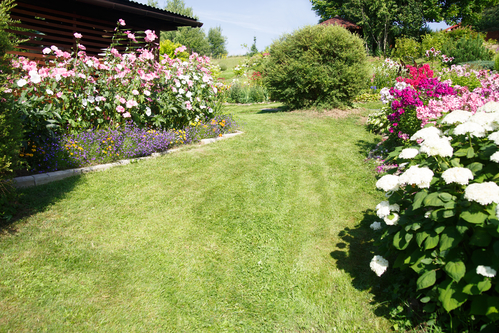
The best garden begins with the selection of the right plants to complement your landscape design and practical needs. In general, the first issue that you should consider when choosing your flora is the purpose of the garden. This space can be used to grow ornamental plants for aesthetic appeal. Alternatively, you can choose to grow edibles such as herbs and vegetables. If you are interested in both edibles and visual impact, it is possible to combine both types of plants.
The climate and environment is also an important consideration during the selection of plants for your garden. If you choose flowers, herbs or vegetables which cannot withstand growth in your local conditions, your garden will fail prematurely. It is advisable to choose indigenous plants because they grow naturally without the need for constant care. You can conduct research on the flora that grows in California for the best decisions.
Define the Boundaries
Boundaries are essential elements in garden design. If your garden does not have clear edges, your landscape will look like a wild land with plants growing haphazardly. Therefore, you must create distinct borders to define the perimeter of your garden and create order. If you would like to have a completely green landscape, consider using a hedge around your garden. For a more formal look, build a fence to isolate the space. It is also possible to edge the garden with stones. The stones will create a boundary without interfering with the visual effect of the garden.
Paths for Your Garden Design
Pathways are essential for a garden, especially one that experiences considerable foot traffic. The paths will allow smooth navigation around the space while protecting the landscape from the dangers of human carelessness. When designing your garden, you should think about the ideal places to form paths. You must also ensure that the path is wide enough for convenient use. To prevent the growth of plants on your pathways, consider installing a pavement or at least pouring gravel.
Borrow the Scenery
Gardens can be made more interesting by borrowing the scene from the surroundings. This borrowed scenery technique involves incorporating the view of a special feature into your garden. Simply speaking, this practice is about capturing the view beyond your own garden. For instance, you can trim the trees in your garden to reveal a distant building, your neighbor’s orchard or a mountain. Though these elements will not be on your property, they will have an impact on the aesthetics.
Enjoy Your Garden
Finally, you should create a comfort zone in your garden to allow you and your guests to enjoy the natural appeal of the space. For instance, a garden bench in a secluded spot might be perfect for settling and reading. A patio bordering the garden might be what you need for entertaining guests.
If you are interested in learning more about garden design, consult our landscaping experts for customized advice and guidance.
![]()
Backyard Ideas: Follow these Steps for Excellent Xeriscaping
Landscaping is great for the air quality around your home, and the curb appeal. However, many people complain that sometimes, it comes at an extremely high cost. One of the costs which are part of landscaping is water expenditure. Xeriscaping is an alternative to landscaping where the least possible amount of water is used. The beautiful thing about the process is that the quality of the resulting landscape will not be compromised, but a lot of water will be saved. Here, are some of the best backyard ideas on Xeriscaping which you need to try out.
Take note of problem areas
The start of any watering process should be to have a look at all the parts of the yard, and notice the ones which are easy to water, and also those which are extremely difficult to maintain. Steep slopes are usually the most prone to drought. After mapping out these areas, decide whether you want to keep their vegetation cover or not. If you decide that you want the vegetation cover, convert into perennial crops which do not need a lot of watering to stay alive and healthy, especially in the hot season. You might also want to consider drip irrigation to maintain these parts of the lawn.
Manage the size of the backyard garden
Another reason a lot of water gets wasted in irrigation is when the garden has an irregular shape. To combat this, you have to reshape the garden to create shapes which are easy to irrigate. You also need to replace the plants with xeric alternatives such as blue grass and buffalo grass, both of which take wear and tear very well. Buffalo grass can survive on less water; however, it has a low tolerance to interferences such as foot traffic, which makes it best suited for parts of the lawn that will not have a lot of traffic. Section off parts of the garden that are used less often, and turn them into shrub borders and flower gardens, that need less water to thrive.
You can also section off parts of the garden and make them into paths. You can line these paths with stepping stones of flagstones, which is good because it reduces the total surface area which has to be covered with lawn grass. Another tip which will be successful is transforming the rocky parts of the garden into a rock garden. You can use a variety of colorful rocks for the garden and use appropriate rock garden designs. There is a variety of crops which you can add to the rock garden.
Picking the right plants
The best plants for backyard ideas in xeriscaping are native and drought tolerant plants. Remember that xeriscape gardens are created in such a way that they fit Mediterranean and Southwest styles in gardening. You can consult with a landscaping expert to figure out the plants which will be most appropriate for your climate and locality.
When Xeriscaping is planned for and done properly, it produces some of the best gardens. It capitalizes on preserving native plants while at the same time reducing the amount of water used in gardening, and giving the regular landscape of your backyard a special touch. When you involve a competent landscaping expert in the process, the outcome will be amazing.
Lawn Treatment Tips
Proper maintenance of your lawn is crucial for a perfect residential landscape. If the right upkeep practices are not upheld, the lawn will deteriorate. Invasive weeds will grow on the land, the plants will lose their lushness and the grass might begin to wither. On the other hand, if you make time for lawn care, you will preserve the natural appeal of your yard. Here are simple lawn treatment tips to help you keep your residential landscape beautiful and healthy.
Aerate the Lawn Soil
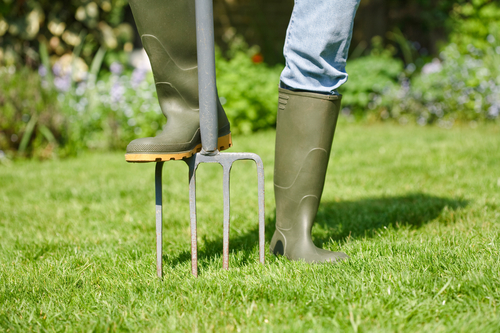
Compacted soil does not support the efficient growth of grass. If the ground is too compact, the roots of the grass will not grow deep. Moreover, water, air and nutrients will not be mobile and readily available in the soil. Fortunately, you can relieve compaction and aerate the lawn soil by creating holes in the ground at intervals. There are specialized tools for aeration, but a simple garden fork will also be effective. You will only need to push the prongs into the ground at short intervals.
Apply Suitable Fertilizer
Feeding the lawn with fertilizer can improve the appearance and health of the grass. The treatment will provide the nutrients which might be absent from the soil. If your landscape is large, it is advisable to acquire specialized equipment for nutrients feeding. However, if the lawn is relatively small, you can manually apply the fertilizer to the grass. Ideally, the material should be used during the rainy season. Fertilizer will burn the grass if it stays on the blades. If it does not rain, you should irrigate the yard thoroughly to allow the nutrients to sink to the soil.
Plan on Over-seeding
Over-seeding is a beneficial practice for old and tired lawns. It is advisable to consider this process if your lawn is showing signs of thinning out, or there are bare patches on the land. In general, over-seeding involves covering the entire loan with a mixture of grass seeds and fertilizer. When these seeds grow, they will fill in the gaps between the thinning areas of the lawn, creating a lush and uniform landscape. If you decide to carry out this process, remember to keep the lawn moist to facilitate germination.
Mow the Lawn Correctly
Mowing is an important part of keeping your lawn in good condition. However, if you do not perform this maintenance process correctly, you could cause more harm to your landscape. Where possible, it is prudent to have your grass mowed by a skilled professional. If you must handle the work, you must remember to only cut about a third of the total grass length. Cutting more will compromise the growth of the grass. You must also avoid mowing wet grass because moisture causes clumping. Mowing the lawn in this condition increases the risk of patching.
Going Beyond Lawn Treatment Tips
Maintaining a beautiful landscape is not only as simple as upholding simple lawn treatment tips. The best upkeep and care practices require effort, time, skill and experience. Therefore, if you are interested in improving your residential lawn for long-term health and aesthetics, consider consulting our experts at DK Landscaping Inc. Whether you need mowing and edging or fertilization and weed management, you will receive the best services for a beautiful home.
![]()


